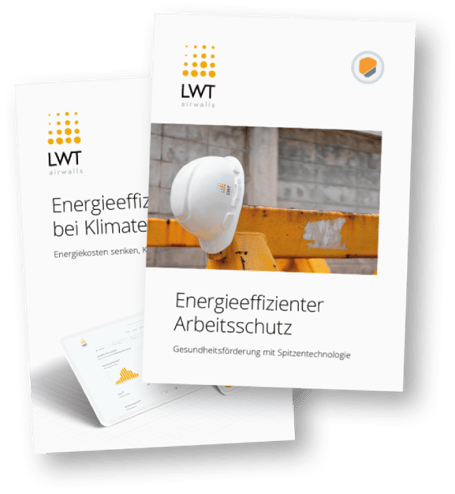
More than just hot air: heat insulation with Airwalls
According to the Federal Environment Agency, more than half of the energy generated in Germany is used for heating. The larger the room, the more expensive heating is - and the more difficult it is to maintain the desired temperature. Better insulation lowers heating costs and reduces the ecological footprint. But to consistently keep heat indoors, doors and gates must also be protected against heat loss, especially cold draughts. Airwalls are suitable for this, keeping the cold air where it should stay: outside.
Most cold insulation ends at the hall door
Logistics companies and businesses with large halls know the problem: when products have to be loaded in winter, heat escapes from the interior rooms. Doors must be kept open so that employees can work without delay. Many companies therefore attach plastic curtains to the doors to keep the draught at bay even when the doors are open.
The problem is also well known in the retail sector: At many entrances to department stores or grocery shops, air curtains are found that blow warm air into the entrance area to hold back cold air. Alternatively, revolving doors are often used to reduce the loss of heated air. High-speed doors can ice up, airlocks are only helpful if a door remains closed. These solutions are not efficient.
None of these measures solve these problems. Plastic curtains are unsuitable because they do not adequately stop draughts and at the same time make it difficult to work with loading aids such as forklift trucks or autonomous logistics vehicles. Revolving doors push expensively heated air outside and frustrate customers. Air curtains are imprecise and consume a lot of energy themselves to heat the outflowing air. So how can the problem be solved? With airwalls.
Reaching the goal with speed: Airwalls keep cold air out
Airwalls are the ideal solution for reliably keeping out cold air and reducing operating costs at the same time. Layers of air can be separated Due to the high air speed, little air volume is required, so that energy consumption is lower than with air curtains. With heating coils, airwalls themselves can generate warm air in an energy-efficient way, maintaining an even temperature indoors. They are also effective insulation, when vehicles are parked in open loading bays or many employees need to pass through for an extended period of time.
Read our casebooks to find out how versatile our technologies are.

Learn more in our casebooks
- Energy efficiency
- Occupational safety
What our airwalls can do:
- reduce energy consumption
- keep heat in the places where it is needed
- seal access points without making them impassable for employees
- increase well-being in the workplace
- can themselves become part of the heating system with its fan coils
We have high sustainability goals and are pleased to have found in LWT GmbH a supplier who takes the United Nations' "Agenda for Sustainable Development" as seriously as we do.
Due to the clean separation between warm and cold air, the colleagues near the air wall have one of the coolest workplaces in summer and one of the warmest in winter!
OBI Germany
Do you have any questions?
We will be happy to advise you!
FAQ
Airwalls are systems that accelerate air to high speeds with the help of fans and compress it into a thin jet via a patented nozzle (pressure linear module). The generated air jet prevents layers of air from mixing. Our units can be mounted on the side of gates or above doors. The air jet then separates the air over the entire height. This keeps cold air outside in winter, for example, and does not cool the air indoors. Airwalls are modular and therefore have a lot of planning freedom. They can therefore also be retrofitted without any problems.
Air curtains have a lower air velocity and need a large volume of air to function. As a result, air curtains do not separate different layers of air, but mix them. As a result, if they are used to keep warm air indoors, for example, they need much more energy because they have to heat more air and the heated air mixes directly with the cold outside air. Our systems, on the other hand, work with a small volume of air at high speed and can thus reliably keep air milieus apart. This makes airwalls more energy-efficient and helps companies achieve climate protection goals.
Our Airwall Compact can be installed by customers themselves. For larger installations like our Airwall Grand, we work together with customers to plan the project, manage the installation and control the result. We work together with long-standing partners who take care of the optimal installation with a lot of expertise and enthusiasm. All planning steps are transparent and discussed with customers. Depending on the size and other general conditions, however, the installation can take different lengths of time.
Since airwalls reduce energy consumption in the long term, an investment usually pays off after a short time. The payback depends on the type of use, the size of the doors and the building, as well as energy prices. The mix of energy sources for electricity also plays a decisive role. However, most of our air walls pay for themselves very quickly. They are beneficial for the climate from the very first minute.

